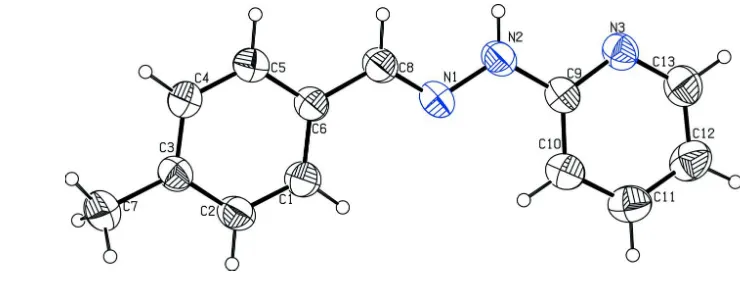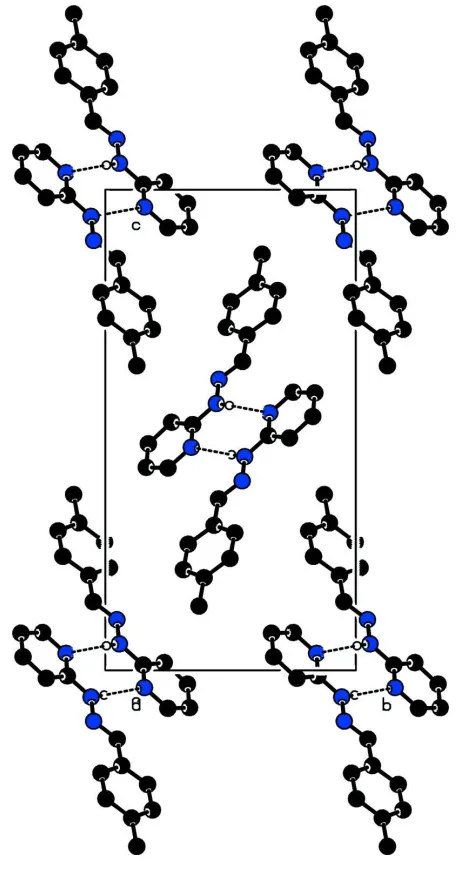(
Z
)-2-[2-(4-Methylbenzylidene)-hydrazinyl]pyridine
Haldorai Yuvaraj,a* S. Sundaramoorthy,bD. Velmuruganb and Rajesh G. Kalkhambkarc
aSchool of Display and Chemical Engineering, Yeungnam University, Gyeongsan, Gyeongbuk 712-749, Republic of Korea,bCentre of Advanced Study in
Crystallography and Biophysics, University of Madras, Guindy Campus, Chennai 600 025, India, andcDepartment of Chemistry, Karnatak Universitys Karnatak Science College, Dharwad 580 001, Karnataka, India
Correspondence e-mail: yuvraj_pd@yahoo.co.in
Received 9 December 2010; accepted 14 December 2010
Key indicators: single-crystal X-ray study;T= 293 K; mean(C–C) = 0.003 A˚; Rfactor = 0.045;wRfactor = 0.154; data-to-parameter ratio = 19.4.
Molecules of the title compound, C13H13N3, are essentially
planar (r.m.s. deviation for all non-H atoms = 0.054 A˚ ). The dihedral angle between the two aromatic rings is 6.33 (5). In
the crystal, pairs of centrosymmetrically related molecules are linked through N—H N hydrogen bonds, forming N— H N dimers with graph-set motifR2
2
(8).
Related literature
For the biological activity of hydrazone derivatives, see: Savini et al. (2002); Silva et al. (2004). For a related structure, see: Yuvarajet al.(2010). For hydrogen-bond motifs, see: Bernstein et al.(1995).
Experimental
Crystal data
C13H13N3 Mr= 211.26
Monoclinic,P21=c a= 5.2385 (8) A˚
b= 10.7215 (17) A˚
c= 20.590 (3) A˚
= 92.699 (5)
V= 1155.2 (3) A˚3
Z= 4
MoKradiation
= 0.08 mm1
T= 293 K
0.260.230.21 mm
Data collection
Bruker SMART APEXII area-detector diffractometer Absorption correction: multi-scan
(SADABS; Bruker, 2008)
Tmin= 0.981,Tmax= 0.984
10622 measured reflections 2850 independent reflections 1341 reflections withI> 2(I)
Rint= 0.027
Refinement
R[F2> 2(F2)] = 0.045 wR(F2) = 0.154
S= 1.00 2850 reflections
147 parameters
H-atom parameters constrained
max= 0.14 e A˚
3
min=0.11 e A˚
[image:1.610.52.230.506.672.2]3
Table 1
Hydrogen-bond geometry (A˚ ,).
D—H A D—H H A D A D—H A
N2—H2A N3i 0.86 2.28 3.131 (2) 170 Symmetry code: (i)xþ1;y;z.
Data collection:APEX2(Bruker, 2008); cell refinement:SAINT (Bruker, 2008); data reduction:SAINT; program(s) used to solve structure:SHELXS97(Sheldrick, 2008); program(s) used to refine structure: SHELXL97 (Sheldrick, 2008); molecular graphics: ORTEP-3(Farrugia, 1997); software used to prepare material for publication:SHELXL97andPLATON(Spek, 2009).
HY gratefully acknowledges Yeungnam University for the opportunity to work as a Full-Time Foreign Instructor. SS and DV thank the TBI X-ray Facility, CAS in Crystallography and Biophysics, University of Madras, India, for the data collection and the University Grants Commission (UGC & SAP) for financial support.
Supplementary data and figures for this paper are available from the IUCr electronic archives (Reference: BT5435).
References
Bernstein, J., Davis, R. E., Shimoni, L. & Chang, N.-L. (1995).Angew. Chem. Int. Ed. Engl.34, 1555–1573.
Bruker (2008).APEX2,SAINTandSADABS. Bruker AXS Inc., Madison, Wisconsin, USA.
Farrugia, L. J. (1997).J. Appl. Cryst.30, 565.
Savini, L., Chiasserini, L., Gaeta, A. & Pellerano, C. (2002).Bioorg. Med. Chem.10, 2193–2198.
Sheldrick, G. M. (2008).Acta Cryst.A64, 112–122.
Silva, G. A., Costa, L. M. M., Brito, F. C. F., Miranda, A. L. P., Barreiro, E. J. & Fraga, C. A. M. (2004).Bioorg. Med. Chem.12, 3149–3158.
Spek, A. L. (2009).Acta Cryst.D65, 148–155.
Yuvaraj, H., Sundaramoorthy, S., Velmurugan, D. & Kalkhambkar, R. G. (2010).Acta Cryst.E66, o2733.
Acta Crystallographica Section E Structure Reports
Online
supporting information
Acta Cryst. (2011). E67, o178 [https://doi.org/10.1107/S1600536810052372]
(
Z
)-2-[2-(4-Methylbenzylidene)hydrazinyl]pyridine
Haldorai Yuvaraj, S. Sundaramoorthy, D. Velmurugan and Rajesh G. Kalkhambkar
S1. Comment
The title compound was prepared as part of our continuing interest on the nitrogen based heterocycles (Yuvaraj et al.,
2010).
In the title molecule, the C2—C3—C7 and C8—N1—N2 bond angles are 121.65 (2)° and 117.46 (2)°, respectively. The
benzene and pyridine form a dihedral angle of 6.33 (5)°.
In the crystal structure,the molecules at (x, y, z) and (1 - x,-y,-z) are linked by N(2)—H(2 A)···N(3) hydrogen bonds,
generating a centrosymmetric dimeric ring motif R22(8) (Bernstein et al., 1995). The centroid of the R22(8) motif lies at
(1/2,0,0). In addition, there is a weak C—H···N interaction linking the centrosymmetric pair of molecules.
S2. Experimental
A mixture of 2-hydrazinopyridine and p-tolualdehyde were refluxed in ethanol with a catalytic quantity of con. HCl or gl.
AcOH. After the reaction was over, the contents were cooled down and filtered to form the product. Diffraction quality
crystals were obtained upon recrystallization in ethanol.
S3. Refinement
H atoms were positioned geometrically (N—H = 0.86 Å, C—H = 0.93–0.98 Å) and allowed to ride on their parent atoms,
[image:2.610.103.473.462.604.2]with 1.5Ueq(C) for methyl H or 1.2 Ueq(C,N) for other H atoms.
Figure 1
Figure 2
The crystal packing of the molecules viewed down a axis. For clarity, hydrogen atoms which are not involved in
hydrogen bonding are omitted
(Z)-2-[2-(4-Methylbenzylidene)hydrazinyl]pyridine
Crystal data
C13H13N3 Mr = 211.26
Monoclinic, P21/c
Hall symbol: -P 2ybc
a = 5.2385 (8) Å
b = 10.7215 (17) Å
c = 20.590 (3) Å
β = 92.699 (5)°
V = 1155.2 (3) Å3 Z = 4
F(000) = 448
Dx = 1.215 Mg m−3
Mo Kα radiation, λ = 0.71073 Å Cell parameters from 715 reflections
θ = 2.0–28.4°
Data collection
Bruker SMART APEXII area-detector diffractometer
Radiation source: fine-focus sealed tube Graphite monochromator
ω and φ scans
Absorption correction: multi-scan (SADABS; Bruker, 2008)
Tmin = 0.981, Tmax = 0.984
10622 measured reflections 2850 independent reflections 1341 reflections with I > 2σ(I)
Rint = 0.027
θmax = 28.4°, θmin = 2.0° h = −6→6
k = −12→14
l = −27→27
Refinement
Refinement on F2
Least-squares matrix: full
R[F2 > 2σ(F2)] = 0.045 wR(F2) = 0.154 S = 1.00 2850 reflections 147 parameters 0 restraints
Primary atom site location: structure-invariant direct methods
Secondary atom site location: difference Fourier map
Hydrogen site location: inferred from neighbouring sites
H-atom parameters constrained
w = 1/[σ2(F
o2) + (0.0649P)2 + 0.0987P]
where P = (Fo2 + 2Fc2)/3
(Δ/σ)max < 0.001
Δρmax = 0.14 e Å−3
Δρmin = −0.11 e Å−3
Extinction correction: SHELXL97 (Sheldrick, 2008), Fc*=kFc[1+0.001xFc2λ3/sin(2θ)]-1/4
Extinction coefficient: 0.011 (3)
Special details
Geometry. All e.s.d.'s (except the e.s.d. in the dihedral angle between two l.s. planes) are estimated using the full covariance matrix. The cell e.s.d.'s are taken into account individually in the estimation of e.s.d.'s in distances, angles and torsion angles; correlations between e.s.d.'s in cell parameters are only used when they are defined by crystal symmetry. An approximate (isotropic) treatment of cell e.s.d.'s is used for estimating e.s.d.'s involving l.s. planes.
Refinement. Refinement of F2 against ALL reflections. The weighted R-factor wR and goodness of fit S are based on F2,
conventional R-factors R are based on F, with F set to zero for negative F2. The threshold expression of F2 > σ(F2) is used
only for calculating R-factors(gt) etc. and is not relevant to the choice of reflections for refinement. R-factors based on F2
are statistically about twice as large as those based on F, and R- factors based on ALL data will be even larger.
Fractional atomic coordinates and isotropic or equivalent isotropic displacement parameters (Å2)
x y z Uiso*/Ueq
C1 −0.2431 (4) 0.01692 (17) 0.21369 (9) 0.0756 (5)
H1 −0.2750 0.0866 0.1877 0.091*
C2 −0.3858 (4) −0.00253 (17) 0.26709 (9) 0.0797 (5)
H2 −0.5119 0.0548 0.2766 0.096*
C3 −0.3465 (3) −0.10558 (17) 0.30708 (8) 0.0712 (5) C4 −0.1622 (4) −0.18826 (18) 0.29040 (9) 0.0852 (6)
H4 −0.1341 −0.2594 0.3156 0.102*
C5 −0.0171 (4) −0.16896 (18) 0.23728 (9) 0.0874 (6)
H5 0.1077 −0.2269 0.2276 0.105*
C6 −0.0525 (3) −0.06569 (15) 0.19808 (8) 0.0674 (5) C7 −0.5002 (4) −0.1260 (2) 0.36606 (9) 0.0936 (6)
H7A −0.4823 −0.2110 0.3801 0.140*
H7B −0.6770 −0.1086 0.3553 0.140*
H7C −0.4395 −0.0714 0.4003 0.140*
H8 0.2328 −0.1063 0.1347 0.088* C9 0.1978 (3) 0.15130 (15) 0.01140 (8) 0.0662 (5) C10 −0.0022 (4) 0.23520 (18) 0.01634 (9) 0.0813 (5)
H10 −0.1154 0.2281 0.0496 0.098*
C11 −0.0290 (4) 0.32800 (19) −0.02841 (10) 0.0907 (6)
H11 −0.1607 0.3857 −0.0258 0.109*
C12 0.1387 (4) 0.33637 (19) −0.07751 (11) 0.0951 (6)
H12 0.1231 0.3990 −0.1087 0.114*
C13 0.3290 (4) 0.2497 (2) −0.07891 (10) 0.0895 (6)
H13 0.4430 0.2554 −0.1121 0.107*
N1 0.0784 (3) 0.04629 (14) 0.10557 (6) 0.0720 (4) N2 0.2388 (3) 0.05650 (13) 0.05528 (6) 0.0749 (4)
H2A 0.3623 0.0046 0.0513 0.090*
N3 0.3633 (3) 0.15655 (13) −0.03568 (7) 0.0742 (4)
Atomic displacement parameters (Å2)
U11 U22 U33 U12 U13 U23
C1 0.0777 (12) 0.0642 (10) 0.0860 (12) 0.0007 (9) 0.0162 (9) 0.0076 (9) C2 0.0744 (12) 0.0739 (12) 0.0927 (12) 0.0054 (10) 0.0244 (10) 0.0042 (10) C3 0.0665 (11) 0.0751 (11) 0.0727 (10) −0.0031 (9) 0.0112 (8) 0.0009 (9) C4 0.0932 (14) 0.0836 (13) 0.0798 (12) 0.0151 (11) 0.0158 (10) 0.0178 (10) C5 0.0928 (14) 0.0874 (13) 0.0837 (12) 0.0246 (11) 0.0219 (11) 0.0115 (10) C6 0.0682 (11) 0.0661 (10) 0.0687 (10) −0.0004 (9) 0.0094 (8) −0.0022 (8) C7 0.0926 (14) 0.1023 (15) 0.0878 (13) 0.0005 (12) 0.0244 (11) 0.0100 (11) C8 0.0754 (12) 0.0720 (11) 0.0729 (10) 0.0023 (9) 0.0137 (9) −0.0022 (9) C9 0.0638 (11) 0.0657 (11) 0.0693 (10) −0.0110 (9) 0.0067 (8) −0.0058 (8) C10 0.0767 (12) 0.0795 (12) 0.0884 (12) 0.0016 (11) 0.0117 (10) −0.0051 (11) C11 0.0797 (14) 0.0773 (13) 0.1152 (16) 0.0026 (10) 0.0057 (12) 0.0009 (12) C12 0.0857 (15) 0.0804 (13) 0.1190 (16) −0.0064 (12) 0.0035 (13) 0.0221 (12) C13 0.0778 (13) 0.0941 (14) 0.0976 (14) −0.0129 (12) 0.0151 (10) 0.0157 (12) N1 0.0709 (9) 0.0764 (10) 0.0699 (8) −0.0061 (7) 0.0162 (7) −0.0064 (8) N2 0.0737 (10) 0.0783 (10) 0.0741 (9) 0.0027 (8) 0.0191 (7) 0.0002 (8) N3 0.0671 (9) 0.0762 (10) 0.0801 (9) −0.0092 (7) 0.0115 (8) 0.0036 (8)
Geometric parameters (Å, º)
C1—C2 1.374 (2) C8—N1 1.273 (2)
C1—C6 1.383 (2) C8—H8 0.9300
C1—H1 0.9300 C9—N3 1.332 (2)
C2—C3 1.387 (2) C9—N2 1.370 (2)
C2—H2 0.9300 C9—C10 1.388 (2)
C3—C4 1.366 (2) C10—C11 1.359 (2)
C3—C7 1.504 (2) C10—H10 0.9300
C4—C5 1.377 (3) C11—C12 1.373 (3)
C4—H4 0.9300 C11—H11 0.9300
C5—C6 1.378 (2) C12—C13 1.364 (3)
C6—C8 1.455 (2) C13—N3 1.344 (2)
C7—H7A 0.9600 C13—H13 0.9300
C7—H7B 0.9600 N1—N2 1.3680 (17)
C7—H7C 0.9600 N2—H2A 0.8600
C2—C1—C6 120.95 (17) N1—C8—C6 121.34 (17)
C2—C1—H1 119.5 N1—C8—H8 119.3
C6—C1—H1 119.5 C6—C8—H8 119.3
C1—C2—C3 121.63 (17) N3—C9—N2 115.09 (16)
C1—C2—H2 119.2 N3—C9—C10 123.05 (17)
C3—C2—H2 119.2 N2—C9—C10 121.86 (17)
C4—C3—C2 117.02 (16) C11—C10—C9 118.63 (18)
C4—C3—C7 121.33 (17) C11—C10—H10 120.7
C2—C3—C7 121.65 (17) C9—C10—H10 120.7
C3—C4—C5 121.69 (18) C10—C11—C12 119.8 (2)
C3—C4—H4 119.2 C10—C11—H11 120.1
C5—C4—H4 119.2 C12—C11—H11 120.1
C4—C5—C6 121.46 (18) C13—C12—C11 117.68 (19)
C4—C5—H5 119.3 C13—C12—H12 121.2
C6—C5—H5 119.3 C11—C12—H12 121.2
C5—C6—C1 117.22 (16) N3—C13—C12 124.55 (19)
C5—C6—C8 119.79 (16) N3—C13—H13 117.7
C1—C6—C8 122.99 (16) C12—C13—H13 117.7
C3—C7—H7A 109.5 C8—N1—N2 117.46 (15)
C3—C7—H7B 109.5 N1—N2—C9 118.41 (15)
H7A—C7—H7B 109.5 N1—N2—H2A 120.8
C3—C7—H7C 109.5 C9—N2—H2A 120.8
H7A—C7—H7C 109.5 C9—N3—C13 116.24 (17)
H7B—C7—H7C 109.5
C6—C1—C2—C3 −0.5 (3) N3—C9—C10—C11 −0.8 (3)
C1—C2—C3—C4 −1.1 (3) N2—C9—C10—C11 179.07 (15)
C1—C2—C3—C7 179.13 (16) C9—C10—C11—C12 0.6 (3)
C2—C3—C4—C5 1.6 (3) C10—C11—C12—C13 −0.3 (3)
C7—C3—C4—C5 −178.62 (18) C11—C12—C13—N3 0.2 (3)
C3—C4—C5—C6 −0.6 (3) C6—C8—N1—N2 179.29 (13)
C4—C5—C6—C1 −1.0 (3) C8—N1—N2—C9 174.71 (14)
C4—C5—C6—C8 179.16 (17) N3—C9—N2—N1 179.08 (13)
C2—C1—C6—C5 1.5 (3) C10—C9—N2—N1 −0.8 (2)
C2—C1—C6—C8 −178.67 (16) N2—C9—N3—C13 −179.22 (14) C5—C6—C8—N1 179.65 (16) C10—C9—N3—C13 0.7 (2)
C1—C6—C8—N1 −0.2 (3) C12—C13—N3—C9 −0.3 (3)
Hydrogen-bond geometry (Å, º)
N2—H2A···N3i 0.86 2.28 3.131 (2) 170


